

The SAGE Handbook of Visual Research Methods. SAGE Research Methods is a research methods tool created to help researchers, faculty and students with their research projects.
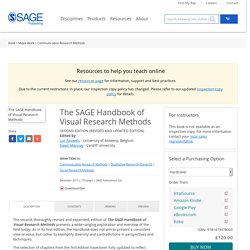
SAGE Research Methods links over 175,000 pages of SAGE’s renowned book, journal and reference content with truly advanced search and discovery tools. Researchers can explore methods concepts to help them design research projects, understand particular methods or identify a new method, conduct their research, and write up their findings.
The SAGE Handbook of Visual Research Methods. SAGE Publications Australia. (99+) (PDF) Making a scientist: Discursive" doing" of identity and self-presentation during research interviews. (99+) (PDF) Participant observation. (99+) (PDF) The Making of Harry and Susie Get Married?: A Performative Approach to Data Collection. Research relationships and responsibilities: ‘Doing’ research with ‘vulnerable’ participants: introduction to the special edition: Social & Cultural Geography: Vol 18, No 7. April 2013: Ethnomining and the combination of qualitative & quantitative data. Image from Fabien Girardin After the two previous editions (Openness and Stories to action), it’s now time for our April edition on combining qualitative and quantitative data.
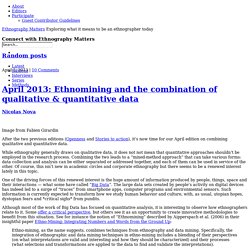
While ethnography generally draws on qualitative data, it does not not mean that quantitative approaches shouldn’t be employed in the research process. Combining the two leads to a “mixed-method approach” that can take various forms: data collection and analysis can be either separated or addressed together, and each of them can be used in service of the other. Article about Reverb. What is Subjective Well-Being? Understanding and Measuring Subjective Well-Being.
Published: 2010-01-16 Brian Albuquerque Subjective well-being (SWB) is defined as ‘a person’s cognitive and affective evaluations of his or her life’ (Diener, Lucas, & Oshi, 2002, p. 63).

The cognitive element refers to what one thinks about his or her life satisfaction in global terms (life as a whole) and in domain terms (in specific areas of life such as work, relationships, etc.) The affective element refers to emotions, moods and feelings. Affect is considered positive when the emotions, moods and feelings experienced are pleasant (e.g. joy, elation, affection etc.) Beall’s List of Predatory Publishers. This is an archive copy of the latest edition of Beall’s list before it went dark.
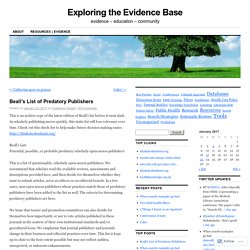
As scholarly publishing moves quickly, this static list will lose relevancy over time. Check out this check-list to help make future decision making easier. Extracting audio from visual information. Researchers at MIT, Microsoft, and Adobe have developed an algorithm that can reconstruct an audio signal by analyzing minute vibrations of objects depicted in video.

In one set of experiments, they were able to recover intelligible speech from the vibrations of a potato-chip bag photographed from 15 feet away through soundproof glass. In other experiments, they extracted useful audio signals from videos of aluminum foil, the surface of a glass of water, and even the leaves of a potted plant. The researchers will present their findings in a paper at this year’s Siggraph, the premier computer graphics conference.
“When sound hits an object, it causes the object to vibrate,” says Abe Davis, a graduate student in electrical engineering and computer science at MIT and first author on the new paper. “The motion of this vibration creates a very subtle visual signal that’s usually invisible to the naked eye. Commodity hardware In other experiments, however, they used an ordinary digital camera. 6 Critical Thinking Skills You Need to Master Now. Critical thinking skills are extremely important in developing a successful career.
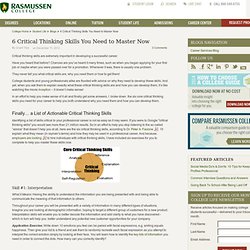
Have you heard that before? Chances are you’ve heard it many times, such as when you began applying for your first job or maybe when you were passed over for a promotion. Whenever it was, there is usually one problem. They never tell you what critical skills are, why you need them or how to get them! College students and young professionals alike are flooded with advice on why they need to develop these skills. The Experience of interactive art: a curatorial study. Abstract: Interactive art exists through the participation of its audience.
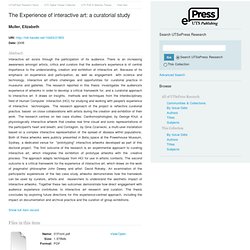
The matter of "generalizability" in qualitative researches. Affective Sciences. On this page we propose research materials and tools that we are willing to share, free of charge, with qualified emotion researchers, irrespective of their discipline, for use in non-commercial research projects.

We have developed, validated and published a number of instruments to test emotion recognition ability in different modalities. Many of these instruments are shared with qualified researchers. More information can be found on our special site for Emotional Competence (EC), under Research Tools, on this page. We have also developed a research corpus with many major emotions enacted by professional actors, using affect induction procedures – the Geneva Multimodal Emotion Portrayals (GEMEP), recorded on high quality video. Parts of this corpus are also shared with qualified researchers and are widely used in the community. 1. GAQ English versionGAQ Version FrançaiseGAQ Deutsche Version 2.
www.lc.unsw.edu.au/onlib/pdf/apa.pdf. Social Research Methods.